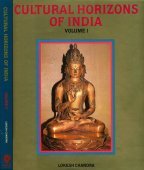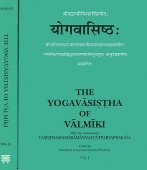Sankshepa, Samkshepa, Saṅkṣepa, Saṃkṣepa: 21 definitions
Introduction:
Sankshepa means something in Buddhism, Pali, Hinduism, Sanskrit, Jainism, Prakrit, Marathi, Hindi. If you want to know the exact meaning, history, etymology or English translation of this term then check out the descriptions on this page. Add your comment or reference to a book if you want to contribute to this summary article.
The Sanskrit terms Saṅkṣepa and Saṃkṣepa can be transliterated into English as Sanksepa or Sankshepa or Samksepa or Samkshepa, using the IAST transliteration scheme (?).
In Hinduism
Ayurveda (science of life)
Source: gurumukhi.ru: Ayurveda glossary of termsSaṃkṣepa (संक्षेप):—Contraction of body parts

Āyurveda (आयुर्वेद, ayurveda) is a branch of Indian science dealing with medicine, herbalism, taxology, anatomy, surgery, alchemy and related topics. Traditional practice of Āyurveda in ancient India dates back to at least the first millenium BC. Literature is commonly written in Sanskrit using various poetic metres.
Yoga (school of philosophy)
Source: Brill: Śaivism and the Tantric Traditions (yoga)Saṅkṣepa (सङ्क्षेप) refers to “brief (explanation)”, according to Śivānandasarasvatī’s Yogacintāmaṇi, a 17th-century text on Haṭhayoga by consisting of 3423 verses.—Accordingly, “Meditation along with the practices [ancillary to it] have been explained briefly (saṅkṣepa—saṅkṣepeṇa nirūpitam) by me according to scripture and my understanding. Listening to and contemplating [the teachings] which are seen in detail and at length only in the Upaniṣads, have not been discussed for fear of prolixity. [...]”.
Source: ORA: Amanaska (king of all yogas): A Critical Edition and Annotated Translation by Jason BirchSaṅkṣepa (सङ्क्षेप) refers to “briefly expounding (a particular subject)”, according to the 17th century Yogacintāmaṇi by Śivānanda: a large compilation of roughly 3423 verses dealing with the various methods of (Haṭha) Yoga and Aṣṭāṅgayoga.—Accordingly, while discussing the scope of his work: “The [subject of] meditation along with the practices [ancillary to it] have been expounded briefly (saṅkṣepa) by me according to scripture and [my] understanding. Vedic study and contemplation which is taught only in the Upaniṣads has not been spoken of in detail [nor] at length for fear of prolixity. [...]”.

Yoga is originally considered a branch of Hindu philosophy (astika), but both ancient and modern Yoga combine the physical, mental and spiritual. Yoga teaches various physical techniques also known as āsanas (postures), used for various purposes (eg., meditation, contemplation, relaxation).
Shaivism (Shaiva philosophy)
Source: SOAS University of London: Protective Rites in the Netra TantraSaṃkṣepa (संक्षेप) refers to a “brief (discourse)”, according to the Netratantra of Kṣemarāja: a Śaiva text from the 9th century in which Śiva (Bhairava) teaches Pārvatī topics such as metaphysics, cosmology, and soteriology.—Accordingly, [verse 21.9cd-14]—“[...] The Gods and Asuras view mantras are seen as powerful and invincible. [Mantras] confer benefits [because they are] all-favoring, all-bestowing, all-pervading, and Śiva. Briefly (saṃkṣepa), O Mahadeva, speak to my question. There is not anyone higher than yourself, O Lord of the World. Please tell all, O Great Śiva, if I please you, O Lord”.

Shaiva (शैव, śaiva) or Shaivism (śaivism) represents a tradition of Hinduism worshiping Shiva as the supreme being. Closely related to Shaktism, Shaiva literature includes a range of scriptures, including Tantras, while the root of this tradition may be traced back to the ancient Vedas.
Shaktism (Shakta philosophy)
Source: ORA: Amanaska (king of all yogas): (shaktism)Saṅkṣepa (सङ्क्षेप) refers to a “brief explanation”, according to the 17th century Kaulagajamardana (“crushing the Kaula elephant”) authored by Kāśīnātha or Kṛṣṇānandācala.—Accordingly, [as Īśvara said to Pārvatī]: “[...] O great Goddess, hear about the Jain. [...] Some are called, 'great guru', and others pursue nonviolence. These are the different varieties in brief (saṅkṣepa) [ca bhedās saṅkṣepatas tv ime]; they are [all] called Pāṣaṇḍas [because] they have been excluded from the vedic path. [...]”

Shakta (शाक्त, śākta) or Shaktism (śāktism) represents a tradition of Hinduism where the Goddess (Devi) is revered and worshipped. Shakta literature includes a range of scriptures, including various Agamas and Tantras, although its roots may be traced back to the Vedas.
In Buddhism
Mahayana (major branch of Buddhism)
Source: Wisdom Library: Maha Prajnaparamita SastraSaṃkṣepa (संक्षेप) refers to “brief (explanation)”, according to Mahāprajñāpāramitāśāstra (chapter 41).—Accordingly, “[The eighteen āveṇika-dharmas (‘special attributes’)]—[...] This is why, although he preaches the limitless emptiness (atyantaśūnyatā) of dharmas, the Buddha also speaks of his unhindered penetration of the three times; there is nothing wrong in this. This is a brief explanation (saṃkṣepa-nirdeśa) of the meaning of the eighteen special attributes of the Buddhas”.

Mahayana (महायान, mahāyāna) is a major branch of Buddhism focusing on the path of a Bodhisattva (spiritual aspirants/ enlightened beings). Extant literature is vast and primarely composed in the Sanskrit language. There are many sūtras of which some of the earliest are the various Prajñāpāramitā sūtras.
Tibetan Buddhism (Vajrayana or tantric Buddhism)
Source: Brill: Śaivism and the Tantric Traditions (tantric Buddhism)Samkṣepa (सम्क्षेप) refers to an “abridgement” (of a teaching), according to the Bhūśalyasūtrapātananimittavidhi section of Jagaddarpaṇa’s Ācāryakriyāsamuccaya, a text within Tantric Buddhism dealing with construction manual for monasteries etc.—Accordingly, “[...] If [someone] touches [a particular part of] his body and [the site] is quickly dug to a depth up to that [particular part of the body] according to the rules, then there is the [extraneous thing corresponding to the omen]. [With regard to bodily sensations,] various omens of extraneous things [beneath the site] are taught. In this [short section], however, [the explanation is] just abridged (samkṣepa-mātra). [...]”.

Tibetan Buddhism includes schools such as Nyingma, Kadampa, Kagyu and Gelug. Their primary canon of literature is divided in two broad categories: The Kangyur, which consists of Buddha’s words, and the Tengyur, which includes commentaries from various sources. Esotericism and tantra techniques (vajrayāna) are collected indepently.
In Jainism
General definition (in Jainism)
Source: The University of Sydney: A study of the Twelve ReflectionsSaṃkṣepa (संक्षेप) refers to “conciseness”, according to the 11th century Jñānārṇava, a treatise on Jain Yoga in roughly 2200 Sanskrit verses composed by Śubhacandra.—Accordingly, “That (i.e. meditation) is reckoned to be of three kinds by some who have a liking for conciseness (saṃkṣepa-ruci) from the [Jain] canon which ascertains the nature of the self because the intention of living beings is of three kinds. Now the three— In that regard, it is said that the first is auspicious intention, its opposite is inauspicious intention [and] the third is called pure intention”.

Jainism is an Indian religion of Dharma whose doctrine revolves around harmlessness (ahimsa) towards every living being. The two major branches (Digambara and Svetambara) of Jainism stimulate self-control (or, shramana, ‘self-reliance’) and spiritual development through a path of peace for the soul to progess to the ultimate goal.
Languages of India and abroad
Marathi-English dictionary
Source: DDSA: The Molesworth Marathi and English Dictionarysaṅkṣēpa (संक्षेप).—m (S) Abridging, abbreviating: also abridged or abbreviated state or form. 2 An abridgment, epitome, compendium, summary, digest.
Source: DDSA: The Aryabhusan school dictionary, Marathi-Englishsaṅkṣēpa (संक्षेप).—m Abridging; an abridgment, summary.
Marathi is an Indo-European language having over 70 million native speakers people in (predominantly) Maharashtra India. Marathi, like many other Indo-Aryan languages, evolved from early forms of Prakrit, which itself is a subset of Sanskrit, one of the most ancient languages of the world.
Sanskrit dictionary
Source: DDSA: The practical Sanskrit-English dictionarySaṃkṣepa (संक्षेप).—
1) Throwing together.
2) Compression; abridgment.
3) Brevity, conciseness.
4) An epitome, a brief exposition.
5) Throwing, sending
6) Taking away.
7) Assisting in another's duty.
8) Destruction (saṃhāra); प्रजासंक्षेपसमये दण्डहस्तमिवान्तकम् (prajāsaṃkṣepasamaye daṇḍahastamivāntakam) Mahābhārata (Bombay) 3.155.27.
9) Total, aggregate. (saṃkṣepeṇa, saṃkṣepatas are used adverbially in the sense of briefly, concisely, shortly; Kull. on Manusmṛti 1.68.)
Derivable forms: saṃkṣepaḥ (संक्षेपः).
Source: Cologne Digital Sanskrit Dictionaries: Shabda-Sagara Sanskrit-English DictionarySaṃkṣepa (संक्षेप).—m.
(-paḥ) Abridgment: see saṅkṣepa .
Source: Cologne Digital Sanskrit Dictionaries: Shabda-Sagara Sanskrit-English DictionarySaṅkṣepa (सङ्क्षेप).—m.
(-paḥ) 1. Abridgment, abbreviation, conciseness, compression. 2. Sending. 3. Throwing. 4. Taking away. 5. Assisting in another’s duty. E. sam before kṣipa to throw or send aff. ghañ .
Source: Cologne Digital Sanskrit Dictionaries: Benfey Sanskrit-English DictionarySaṃkṣepa (संक्षेप).—i. e. sam-kṣip + a, m. 1. Throwing together; instr. eṇa, In all, [Mānavadharmaśāstra] 7. 157. 2. Abridgment, Mahābhārata 1, 102; [Pañcatantra] 4, 17; iii. [distich] 103 (pāt, in a few words). 3. Conciseness. 4. Throwing. 5. Sending. 6. Taking away. 7. Assisting in another’s duty.
Source: Cologne Digital Sanskrit Dictionaries: Cappeller Sanskrit-English DictionarySaṃkṣepa (संक्षेप).—[masculine] throwing together, either destroying or abridging, compressing, [especially] succinct or concise exposition, recapitulation.
Source: Cologne Digital Sanskrit Dictionaries: Monier-Williams Sanskrit-English Dictionary1) Saṃkṣepa (संक्षेप):—[=saṃ-kṣepa] [from saṃ-kṣip] m. throwing together, destruction, [Mahābhārata]
2) [v.s. ...] compression, comprehension, condensation, abridgment, conciseness, brief exposition, compendium, epitome, essence or quintessence ([in the beginning of a compound], āt, eṇa, am or pa-tas, ‘briefly’, ‘concisely’, ‘in short’), [Mahābhārata; Rāmāyaṇa] etc.
3) [v.s. ...] the whole thrown together, total, aggregate (eṇa and pa-tas, ‘in the aggregate’), [Manu-smṛti vii, 167; Manvarthamuktāvalī, kullūka bhaṭṭa’s Commentary on manu-smṛti on i, 68 etc.; Catalogue(s)]
4) [v.s. ...] a means of compressing, [Suśruta]
5) [v.s. ...] ([plural]) straits, poverty, [Mahābhārata]
6) [v.s. ...] (in [dramatic language]) a brief declaration (of willingness to be at the service of another), [Sāhitya-darpaṇa]
7) [v.s. ...] throwing, [Horace H. Wilson]
8) [v.s. ...] taking away, [ib.]
Source: Cologne Digital Sanskrit Dictionaries: Yates Sanskrit-English DictionarySaṅkṣepa (सङ्क्षेप):—[sa-ṅkṣepa] (paḥ) 1. m. Compression, abridgment; throwing, sending, snatching away; interposing.
Source: DDSA: Paia-sadda-mahannavo; a comprehensive Prakrit Hindi dictionary (S)Saṃkṣepa (संक्षेप) in the Sanskrit language is related to the Prakrit words: Saṃkheva, Saṃchobha.
[Sanskrit to German]
Sanskrit, also spelled संस्कृतम् (saṃskṛtam), is an ancient language of India commonly seen as the grandmother of the Indo-European language family (even English!). Closely allied with Prakrit and Pali, Sanskrit is more exhaustive in both grammar and terms and has the most extensive collection of literature in the world, greatly surpassing its sister-languages Greek and Latin.
Hindi dictionary
Source: DDSA: A practical Hindi-English dictionarySaṃkṣepa (संक्षेप) [Also spelled sankshep]:—(nm) a compendium; summary, brief; abbreviation; abridgement; ~[taḥ] in brief/short; —[meṃ] in short, in brief; summarily.
...
Kannada-English dictionary
Source: Alar: Kannada-English corpusSaṃkṣēpa (ಸಂಕ್ಷೇಪ):—
1) [noun] = ಸಂಕ್ಷಿಪ್ತ [samkshipta]2.
2) [noun] a throwing, project (several things) together.
3) [noun] quickness; swiftness; speed.
Kannada is a Dravidian language (as opposed to the Indo-European language family) mainly spoken in the southwestern region of India.
See also (Relevant definitions)
Starts with: Samkshepana, Sankshepak, Sankshepan, Sankshepana, Sankshepatah.
Ends with: Abhisankshepa, Sarasankshepa, Vrittisamkshepa.
Full-text (+88): Upasamkshepa, Samkshepatas, Samkshepam, Samkshepasharirakasambandhokti, Samkshepamatra, Samkshepasharirakabhashya, Samkshepasharirakatika, Samkshepasharirakavyakhyana, Samkshepasharirakaphalalakshana, Samkshepika, Ramayanasamkshepa, Sankshepika, Samksheparamayana, Shamkarajaya, Samkshepagayatrinyasa, Samkshepabhagavatamrita, Samkshepayogavasishtha, Samkshepavimarshadhiroha, Samkshepabharata, Samkshepatithinirnayasara.
Relevant text
Search found 17 books and stories containing Sankshepa, Saṃ-kṣepa, Sam-ksepa, Sam-kshepa, Saṃkṣepa, Samksepa, Saṃkṣēpa, Samkshepa, Saṅkṣepa, Saṅkṣēpa, Sanksepa, Sankṣēpa; (plurals include: Sankshepas, kṣepas, ksepas, kshepas, Saṃkṣepas, Samksepas, Saṃkṣēpas, Samkshepas, Saṅkṣepas, Saṅkṣēpas, Sanksepas, Sankṣēpas). You can also click to the full overview containing English textual excerpts. Below are direct links for the most relevant articles:
Sanskrit sources of Kerala history (by Suma Parappattoli)
12. Ramakatha and Sanksepabharata < [Chapter 6 - Miscellaneous Sanskrit works bearing on Kerala history]
The Agni Purana (by N. Gangadharan)
Chaitanya Bhagavata (by Bhumipati Dāsa)
Verse 1.1.183 < [Chapter 1 - Summary of Lord Gaura’s Pastimes]
Verse 1.8.66 < [Chapter 8 - The Disappearance of Jagannātha Miśra]
A History of Indian Philosophy Volume 2 (by Surendranath Dasgupta)
Part 13 - Sarvajñātma Muni (a.d. 900) < [Chapter XI - The Śaṅkara School of Vedānta (continued)]
Part 26 - Nṛsiṃhāśrama Muni (a.d. 1500) < [Chapter XI - The Śaṅkara School of Vedānta (continued)]
Part 1 - Introduction of the Yogavāsiṣṭha Theme < [Chapter XII - The Philosophy of the Yogavāsiṣṭha]
Preceptors of Advaita (by T. M. P. Mahadevan)
(i) Ātreya Brahmanandi and Draidāchārya < [50. Some Pre-Śaṅkara Advaitins]
The Matsya Purana (critical study) (by Kushal Kalita)
Part 1 - Theories of origin of Kingship < [Chapter 6 - Polity in the Matsyapurāṇa]
Related products


